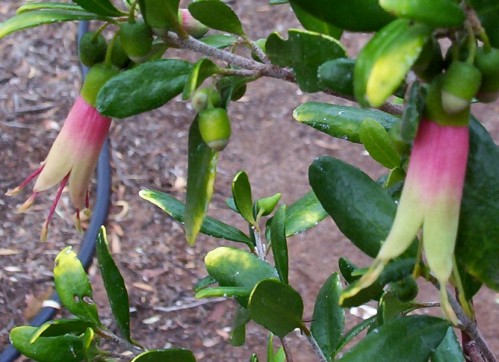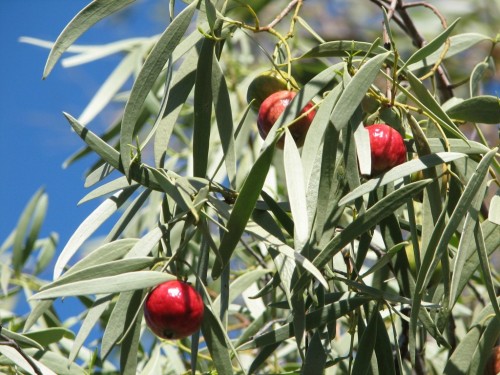Correas In The Garden
I was putting Correa glabra, a variegated form, on to the tables at the Spring Flower Show and Plants Sale organised by the Australian Plants Society. This is a pretty plant. Some Correas have a fruity scent in the leaves, which makes them good to grow near a path where the leaves can be brushed as people walk past them.
Correa glabra exists in a number of forms. What I have is a variegated form which has yellow blotches. The leaves are shiny and the blotching is better seen when the plant is growing out in the open. These Correas need to be tip pruned to keep them dense bushes. A friend made a practice of pinching the top couple of leaves of each branch on the bushes and alsways had prolific flowering as a result. This works with many species.
This particular species grows to about half a metre high and wide and grows well in clay soils that dry and crack in the heat of summer.
Gardening With Australian Native Plants
Last week I received an email from Stuart in Western Australia at Gardening Tips ‘n’ Ideas. He asked me to be featured on his blog by answering a few questions along the lines of ‘When did I begin Gardening as a hobby, Why have a blog, What useful tip had I picked up along the way, etc. The whole article can be read here. A number of gardeners were asked to fill Stuart’s blog entries for a few days, including a some from the USA.
When I looked at what I had written it brought back a lot of memories. The country town we lived in when we were first married had a progressive Parks and Gardens Officer. He began a huge street planting scheme to the extent that this town has a great tree line which is so obvious when compared to the surrounding flat country side of salt bush. These days one would say that mistakes were made regarding species selection but at least there is this lovely greenery in a hot dry area.
I joined the Australian Plant Society in 1976. The magazines and Journals that I have kept for the past 30 years are a fantastic resource. When I consider that what was experimental then is now common place regarding propagating and growing Australian native plants, the accumulated knowledge is phenomenal.
Why do I write about Australian native plants? They are magical in their colours, shape and form. They fit into any garden type, mixed with exotics or on their own. I find them interesting and exciting plants. Many have unique needs to enable propagation. Many have unique needs to be able to grow them in the garden, especially in this country where climatic conditions are so varied. Our native birds, animals and insects need them to survive and the plants themselves need those birds, animals and insects in order to set seed and survive.
Santalum accuminatum (Wild Peach, Quandong)
What a find today! Husband found this on his morning walk today. I knew that they grew up the hill but I thought it was too early for ripe fruit. It is a wonder they are still there with the number of people who drive past.
At a Christmas break up a couple of years ago, one of the Australian Plant Society members made a fabulous Wild Peach Pie, which we had with cream. What a treat.
These seem to be shrubby plants here and I think are suckering plants. They are parasitic and grasses are used as the host in the home garden situation. I did hear that in orchard situations with the extra water and fertiliser, hosts are not needed. I need to research this as I want to have a smalll grove of these. See more information here.
Birds and Plants
The bird life around here is fantastic at the moment. A family of White-winged Choughs often passes through, creating territorial wars with the Little Ravens. Both are feeding young. I had a Blackbird nesting in a stack of pots in my little storage shed. A New Holland Honeyeater is feeding young in a nest in Melaleuca lanceolata near the house. We can watch her coming out to find food and return to the nest from the dining room table. A lot of time gets wasted watching all this activity 😀 .
The insect problems around here would be phenomenal if it was not for the bird life on our block. The Rainbow Bee-eaters arrived yesterday. They are such pretty birds. They usually stay until around February. They tend to stay mainly around the creek at the back of our place, where they make their nests in the cliff.
While I was sorting plants one of the New Holland Honey-eaters flew past the box of plants snatching a small spider dangling on its web.


